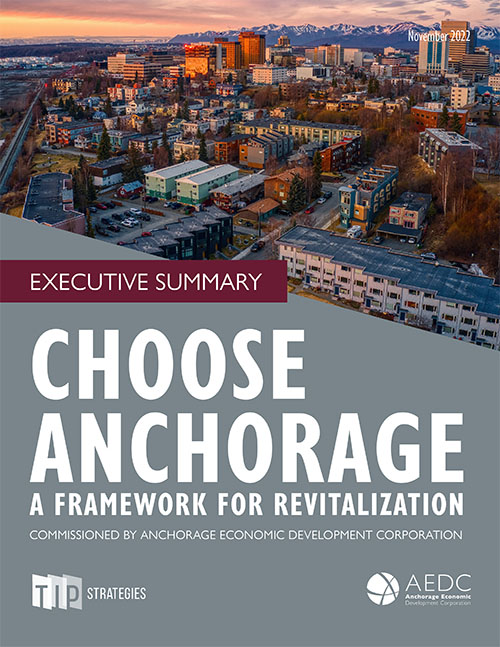Research & Reports
Choose Anchorage: A Framework for Revitalization
Bounded by the Cook Inlet and the Chugach Mountains, Anchorage is situated in one of the most beautiful settings in the world. Within a boundary area of roughly 2,000 square miles, the city is home to scenic parks and trails, an upscale ski resort, top-tier restaurants, and unique cultural and arts amenities. It is a popular destination for visitors and adventure seekers from around the globe. It is strategically located along the Pacific Rim and near the increasingly important Arctic region.
Despite its many assets and amenities, Anchorage faces multiple economic challenges that threaten its long- term prosperity. Chief among them is the ongoing decline in the city’s population due to outmigration. For the past 11 years, more people have moved out of Anchorage than have moved in. And for the past eight years, the migration effect has been large enough to trigger overall population decline. Moreover, Anchorage’s “natural” growth (the difference between births and deaths) has been cut in half since 2014. Certainly, the COVID-19 pandemic is having an impact on this trajectory, but the trend was already well underway before the pandemic.
The loss of population has constrained employment growth. Anchorage eased through the Great Recession in 2007–2009 with relatively little negative impact on job growth and even experienced modest employment gains until 2012. By 2014, however, the US had not only recovered all of its lost jobs, but it had also caught up to Anchorage. Since then, job performance in Anchorage has diverged sharply from national patterns. As of 2021, the national job base was 4.7 percent larger than it had been in 2007. By contrast, Anchorage’s job base was 8.8 percent smaller. The consequences of declines in population and job growth are clear. The city’s employment base, which peaked at 183,000 in 2012, now hovers near 160,000.
These issues are exacerbated by Anchorage’s structural barriers. Its geographic isolation and dependence on imports result in higher costs for consumer goods, housing, food, and building materials. The higher cost of living translates to higher wage rates in a labor market that is already starved for workers. This situation makes Anchorage uncompetitive for labor-intensive manufacturing operations. Mitigating the challenges associated with Alaska’s geographic location requires creativity and the adoption of emerging technologies in areas such as food production and housing construction.

